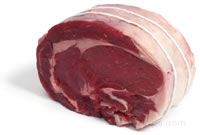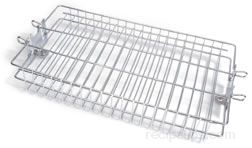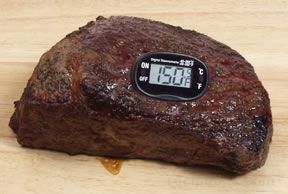|
There are two methods of cooking beef using a rotisserie: direct heat cooking and indirect heat cooking. The method that is used is dependent upon how the rotisserie is positioned in relation to the heat source. Placing the meat over the heat source is direct heat cooking and results in beef with a grilled quality. This works best for small cuts of beef, but direct cooking is rarely used in conjunction with rotisserie cooking. Indirect cooking is most often used because it allows the meat to cook slowly and evenly, which is the primary purpose for using a rotisserie for cooking. The rotisserie is positioned in front of or next to the heat source, which works extremely well for larger cuts of beef. The indirect heat will allow the interior portions of the meat to cook thoroughly before the exterior becomes overdone.
When setting up for rotisserie cooking using a charcoal or gas grill as the heat source, the grills must be preheated before rotisserie cooking can begin. (Refer to Rotisserie Grilling Basics - for details on preheating.) The best results are achieved when beef cuts are seared at a high temperature for the first few minutes, followed by low to medium/low heat for the remainder of the cooking time. A rotisserie ring is beneficial when using a charcoal grill because it allows the spit to be positioned at the perfect height in relation to the heat source.
Examples of Beef Cuts Suited for Rotisserie Cooking
 
Cooking beef with a rotisserie is most successful when cooking beef cuts that have a basic cylindrical shape. Oven roasts, such as a tenderloin roast (pictured above left) or a rolled boneless rib roast (pictured above right), are excellent candidates for rotisserie cooking. Rib-eye roasts and top loin roasts are equally good choices. Tender cuts that are flat or irregularly shaped may be used if they are boned, rolled, and tied. A rotisserie basket (shown below), can also be used for cooking flat pieces of beef, which allows the meat to be cooked on the rotisserie without having to be directly skewered.
Rotisserie Basket

Market ready cuts from the round and chuck are usually not suitable for cooking with a rotisserie because they are tougher and lack the marbling that is important for keeping the meat tender while cooking. However, they can be quite flavorful and acceptably tender if they are not overcooked and if they are marinated for several hours prior to cooking.
Beef can be cooked on a rotisserie using numerous recipes. Most of the recipes can be used for grilling, broiling, or roasting if the cooking time is adjusted accordingly. High quality meat usually does not require too many additional flavorings, so a particular recipe may not be necessary. A coating of olive oil, salt, and pepper may be all that is necessary or a rub of fresh herbs may be used to create a flavorful crust on the exterior. | 



 Rather than relying on a cooking time chart for proper doneness, always use a meat thermometer. The chart does not allow for the many variables that often influence doneness. A cooking time chart should be used as a guide only and should not be used as a substitute for the accuracy of a good meat thermometer. To accurately check temperature, the thermometer must be pushed through the thickest part of the meat and away from any bones (bones conduct heat).
Rather than relying on a cooking time chart for proper doneness, always use a meat thermometer. The chart does not allow for the many variables that often influence doneness. A cooking time chart should be used as a guide only and should not be used as a substitute for the accuracy of a good meat thermometer. To accurately check temperature, the thermometer must be pushed through the thickest part of the meat and away from any bones (bones conduct heat).